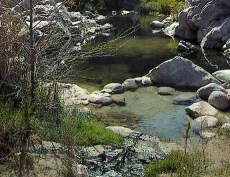Bald eagles soar over Inland
WINTER HOME: Volunteers are needed to count the national symbol.
12/26/2002
By KOREN WETMORE
SPECIAL TO THE PRESS-ENTERPRISE
The first wave of migratory bald eagles has landed in the Inland area, roosting at
lakes in the San Bernardino and San Jacinto mountains.
Volunteers counted 16 eagles Dec. 14, during the first of four scheduled winter
counts and anticipate the arrival of up to 24 more birds before the final count is
taken March 8.
The numbers encourage U.S. Forest Service officials, who have been counting
eagles since the bird was federally listed as a threatened species in 1978.
Although their numbers have not increased, they have remained constant, a sign
that the species is surviving, said Marc Stamer, a Forest Service wildlife biologist
and eagle count coordinator for the San Bernardino National Forest.
"We hold the counts to assess the
status of the eagle population. It helps
us learn their haunts and habits, and
that information helps us to better
manage the species," Stamer said.
Officials have learned much in the past
two decades. They've identified threats
to the eagle population caused by
human disturbances such as
construction, which destroys habitat,
and recreational activities in roosting
areas, which can cause eagles to
abandon nests.
With the help of technology, they also
have discovered that the birds travel farther and move around much more than
previously thought.
Technology-based tracking
In 1999, researchers from the Santa Cruz Predatory Bird Research Group began
fitting Silverwood Lake eagles with backpack transmitters to track the birds'
migratory movement with satellites. The 70-gram pack, about the size of a
matchbox, equals 2 percent of the bird's body weight. Its straps leave room for
wing movement and are designed to wear out in about three years (the
approximate lifespan of the transmitter).
"They don't seem to notice it's there," said Santa Cruz research associate Janet
Linthicum. "They preen the feathers under and around it."
Signals from the pack are picked up by satellites, which calculate and feed data
on the bird's location to a computer in Seattle. The computer then relays the
information to researchers through e-mail.
Tracking data revealed that the local birds come from as far away as Canada's
Great Slave Lake region. Once they reach a destination, they still move around a
lot, Linthicum said. One of the Silverwood eagles would spend mornings at the
lake only to later visit the Salton Sea and the Colorado River before roosting back
at Silverwood.
The movement mirrored radio tracking done by the Forest Service in conjunction
with the Santa Cruz group's study.
"We used to think of them as separate eagle populations: the Silverwood, Lake
Gregory-Lake Arrowhead and Big Bear Lake groups," said Robin Butler, a forest
service biologist. "Now we think of it as one large mountain population."
Tracking by eyesight
Human tracking of eagles involves a one-hour period in which volunteers use
binoculars to scan the sky around a designated lake site, keeping notes on the
size and location of eagles. Volunteers are instructed on how to tell the difference
between golden and bald eagles and adults and juveniles. They carefully
document what they see and return their findings to forest officials.
Although the counts are not as precise as radio and satellite tracking, residents
and eagle count volunteers have added their share of discoveries, Stamer said.
Stamer has received unverified reports of eagle sightings throughout the Inland
area, including at ponds in Yucaipa and Oak Glen. Yet it was the persistent
reporting of residents near Hemet that resulted in the discovery of an eagle pair
at Lake Hemet.
"The pair was consistently seen by residents for the past few years and so I
decided we should monitor the (Lake Hemet eagle) population as well," Stamer
said.
Volunteer experience
Eagle counts are one of the best ways to educate the public about the birds and
the role of humans in the species' survival, Stamer said.
The main goal is to help the species become strong enough to be removed from
the federal list of threatened species, she said.
Counting eagles requires no more than a desire to learn some basic information
and the willingness to stand out in the winter cold to catch a glimpse of the
national symbol.
People who participate once in an eagle count may find themselves hooked, said
Lynn Johnson, eagle count volunteer coordinator and manager of the Mojave
River Natural History Museum. Johnson started counting eagles in 1985 as a
personal pursuit. Silverwood Lake park officials later convinced her to help
coordinate the counts, a task she has enjoyed for the past 15 years.
"The look on people's faces when they see those birds for the first time makes it
all worthwhile," Johnson said. "Over the years I've watched families come and
now their grown children have returned and are bringing their kids to do this."
HOW TO HELP
When: Volunteers are needed for eagle counts Jan. 11, Feb. 8 and March 8.
Where: In the San Bernardino and San Jacinto mountains.
Information: Marc Stamer at (909) 866-3437 or Kim Huber at (909) 659-2117.
Bald Eagles in SB Forest
All posts are those of the individual authors and the owner
of this site does not endorse them. Content should be considered opinion
and not fact until verified independently.
| Subject | Author | Views | Posted |
|---|---|---|---|
| katrina island | 1202 | December 26, 2002 12:12PM | |
| katrina island | 543 | December 26, 2002 02:13PM | |
| Laughing Bear | 972 | December 27, 2002 10:43AM |
Sorry, only registered users may post in this forum.




